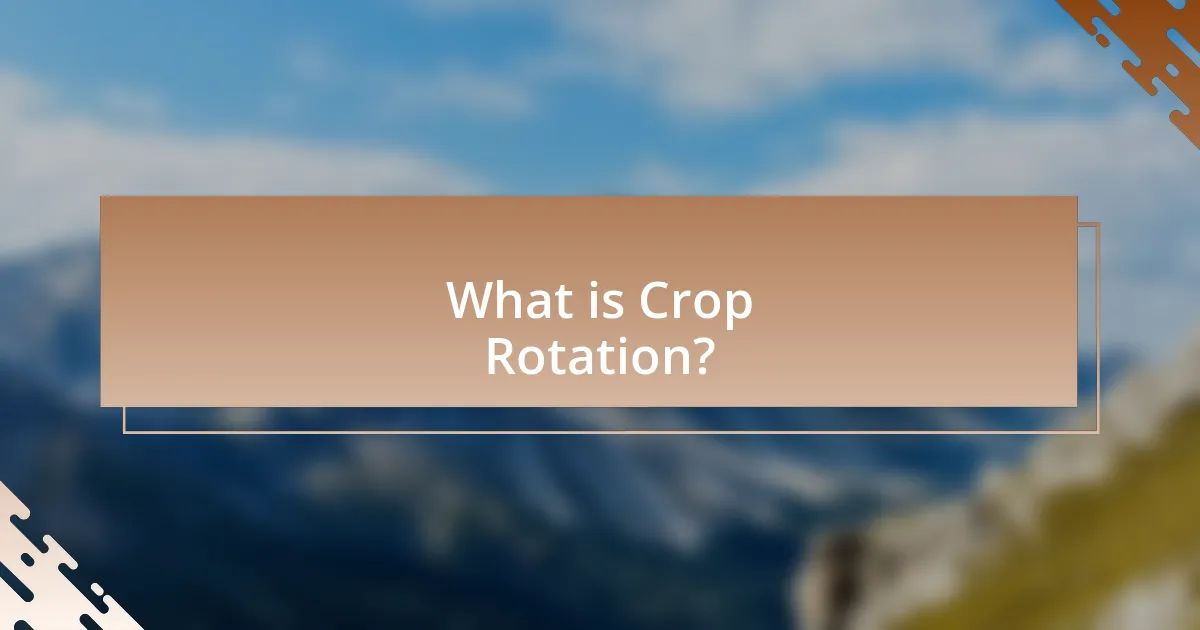Sustainable practices in agriculture, particularly crop rotation and organic certification, are essential for meeting current food production needs while ensuring environmental health and future food security. Crop rotation enhances soil fertility, reduces pest and disease cycles, and can increase yields by up to 20%. Organic certification promotes environmentally friendly farming techniques, ensuring the avoidance of synthetic fertilizers and pesticides, which benefits both farmers and consumers. The article explores the principles of sustainable agriculture, the impact of these practices on soil health, and the economic advantages they offer, highlighting the critical role they play in fostering resilient agricultural systems.

What are Sustainable Practices in Agriculture?
Sustainable practices in agriculture are methods that aim to meet current food production needs without compromising the ability of future generations to meet theirs. These practices include crop rotation, which enhances soil health and reduces pest and disease cycles, and organic certification, which promotes environmentally friendly farming techniques that avoid synthetic fertilizers and pesticides. Research indicates that crop rotation can increase yields by up to 20% and improve soil fertility, while organic farming can reduce environmental impact by promoting biodiversity and reducing chemical runoff.
How do sustainable practices contribute to environmental health?
Sustainable practices contribute to environmental health by enhancing soil quality, reducing pollution, and promoting biodiversity. For instance, crop rotation improves soil structure and fertility, which leads to healthier ecosystems. Research indicates that diverse crop systems can reduce the need for chemical fertilizers and pesticides, thereby minimizing water and soil contamination. Additionally, organic certification encourages practices that maintain ecological balance, such as composting and reduced tillage, which further support soil health and reduce greenhouse gas emissions. These practices collectively foster a more resilient environment, demonstrating their critical role in promoting environmental health.
What are the key principles of sustainable agriculture?
The key principles of sustainable agriculture include maintaining soil health, promoting biodiversity, conserving water, and minimizing chemical use. These principles ensure that agricultural practices are environmentally sound, economically viable, and socially responsible. For instance, maintaining soil health through practices like crop rotation and cover cropping enhances soil fertility and structure, which is supported by research indicating that healthy soils can increase crop yields by up to 20%. Promoting biodiversity helps to create resilient ecosystems, reducing the need for chemical pesticides and fertilizers. Additionally, conserving water through efficient irrigation techniques is crucial, as agriculture accounts for approximately 70% of global freshwater use. These principles collectively contribute to the long-term sustainability of agricultural systems.
How do sustainable practices impact soil health?
Sustainable practices significantly enhance soil health by improving its structure, fertility, and biodiversity. For instance, crop rotation prevents soil depletion by alternating nutrient demands of different crops, which maintains a balanced nutrient profile in the soil. Additionally, organic certification promotes the use of natural fertilizers and pest control methods, reducing chemical runoff and enhancing microbial activity. Research indicates that farms employing sustainable practices can experience up to a 30% increase in soil organic matter, which is crucial for nutrient retention and soil structure. This evidence underscores the positive correlation between sustainable agricultural methods and improved soil health.
Why is sustainability important for future food security?
Sustainability is crucial for future food security because it ensures the long-term availability of resources necessary for food production. Sustainable agricultural practices, such as crop rotation and organic certification, enhance soil health, reduce dependency on chemical inputs, and promote biodiversity, which are essential for resilient food systems. For instance, studies show that crop rotation can increase yields by up to 20% while reducing soil erosion and pest outbreaks. Additionally, organic farming practices can improve soil fertility and water retention, contributing to more stable food supplies in the face of climate change. Thus, sustainability directly supports the capacity to produce food reliably and sustainably for future generations.
What challenges does conventional agriculture face?
Conventional agriculture faces significant challenges, including soil degradation, reliance on chemical inputs, and loss of biodiversity. Soil degradation occurs due to practices such as monoculture and excessive tillage, which can lead to erosion and nutrient depletion. The reliance on chemical fertilizers and pesticides raises concerns about environmental pollution and human health risks, as evidenced by studies linking pesticide exposure to various health issues. Additionally, the loss of biodiversity is a critical challenge, as conventional farming often prioritizes high-yield crops over diverse ecosystems, which can disrupt natural pest control and pollination processes. These challenges highlight the need for more sustainable agricultural practices, such as crop rotation and organic certification, to mitigate negative impacts and promote long-term agricultural viability.
How can sustainable practices mitigate these challenges?
Sustainable practices, such as crop rotation and organic certification, can mitigate agricultural challenges by enhancing soil health and reducing dependency on chemical inputs. Crop rotation improves soil fertility and disrupts pest cycles, leading to increased crop yields and reduced disease prevalence. For instance, a study published in the journal “Agronomy” found that crop rotation can increase yields by up to 20% compared to monoculture systems. Organic certification promotes biodiversity and encourages the use of natural pest control methods, which further decreases the reliance on synthetic pesticides. Research from the “Journal of Sustainable Agriculture” indicates that organic farming practices can lead to a 30% reduction in greenhouse gas emissions compared to conventional farming. These sustainable practices collectively contribute to more resilient agricultural systems, addressing challenges such as soil degradation and climate change.

What is Crop Rotation?
Crop rotation is an agricultural practice that involves alternating the types of crops grown in a specific area across different seasons or years. This method enhances soil fertility, reduces soil erosion, and helps control pests and diseases by disrupting their life cycles. Research indicates that crop rotation can lead to improved yields and reduced reliance on chemical fertilizers and pesticides, as diverse crops contribute to a balanced ecosystem. For example, rotating legumes with cereals can increase nitrogen levels in the soil, benefiting subsequent crops.
How does crop rotation work to enhance soil fertility?
Crop rotation enhances soil fertility by alternating the types of crops grown in a specific area over time. This practice improves soil health through several mechanisms: different crops have varying nutrient requirements and root structures, which helps prevent nutrient depletion and promotes a more balanced soil nutrient profile. For instance, legumes, such as beans and peas, fix nitrogen in the soil, enriching it for subsequent crops that require higher nitrogen levels. Research indicates that crop rotation can increase soil organic matter and microbial diversity, both of which are crucial for maintaining soil fertility. A study published in the journal “Agronomy” by Drinkwater et al. (1998) found that diverse crop rotations significantly improved soil quality and crop yields compared to continuous cropping systems.
What are the different types of crop rotation systems?
The different types of crop rotation systems include simple rotation, complex rotation, and cover cropping. Simple rotation involves alternating two or more crops in a specific sequence, which helps in pest and disease management. Complex rotation incorporates a wider variety of crops over multiple seasons, enhancing soil fertility and biodiversity. Cover cropping, on the other hand, involves planting crops specifically to cover the soil, preventing erosion and improving soil health. These systems are validated by agricultural studies showing that diverse crop rotations can lead to increased yields and reduced reliance on chemical fertilizers and pesticides.
How does crop rotation affect pest and disease management?
Crop rotation significantly enhances pest and disease management by disrupting the life cycles of pests and pathogens. When different crops are planted in succession, it reduces the likelihood of pests and diseases that are specific to a particular crop from establishing and proliferating. For example, rotating crops such as legumes with cereals can lower the populations of root-feeding nematodes and other pests that thrive on specific plants. Research has shown that crop rotation can lead to a 30-50% reduction in pest populations and disease incidence, as diverse cropping systems create an environment less conducive to the survival of harmful organisms. This practice not only promotes healthier crops but also contributes to sustainable agricultural practices by minimizing the reliance on chemical pesticides.
What are the benefits of implementing crop rotation?
Implementing crop rotation enhances soil health, increases biodiversity, and improves crop yields. By alternating different crops, soil nutrients are replenished, reducing the need for chemical fertilizers. Research indicates that crop rotation can lead to a 10-20% increase in yields compared to continuous cropping systems, as diverse root structures and plant families help break pest and disease cycles. Additionally, crop rotation promotes beneficial microorganisms in the soil, which further supports plant growth and resilience.
How does crop rotation improve biodiversity?
Crop rotation improves biodiversity by promoting a diverse range of plant species and enhancing soil health. This practice reduces the dominance of any single crop, which can lead to pest and disease outbreaks, thereby fostering a more balanced ecosystem. Research indicates that rotating crops can increase the abundance and variety of beneficial organisms, such as pollinators and soil microbes, which are crucial for ecosystem stability. For example, a study published in the journal “Agriculture, Ecosystems & Environment” found that crop rotation significantly increased the diversity of soil microbial communities, which are essential for nutrient cycling and plant health.
What economic advantages does crop rotation offer to farmers?
Crop rotation offers significant economic advantages to farmers by enhancing soil fertility, reducing pest and disease pressure, and improving crop yields. By alternating different crops, farmers can maintain nutrient levels in the soil, which leads to lower fertilizer costs; studies show that crop rotation can increase yields by 10-25% compared to monoculture systems. Additionally, rotating crops disrupts pest and disease cycles, reducing the need for chemical pesticides, which further lowers production costs. Research indicates that these practices can lead to a more resilient farming system, ultimately resulting in higher profitability for farmers over time.

What is Organic Certification?
Organic certification is a process that verifies that agricultural products are produced according to specific standards set by regulatory bodies. These standards typically include guidelines on the use of synthetic fertilizers, pesticides, and genetically modified organisms (GMOs), ensuring that the products are grown using environmentally sustainable practices. For instance, in the United States, the USDA National Organic Program establishes the criteria for organic certification, which requires farmers to maintain soil health, promote biodiversity, and use natural pest management techniques. This certification is crucial for consumers seeking assurance that the products they purchase are genuinely organic and produced without harmful chemicals.
How does the organic certification process work?
The organic certification process involves a series of steps that ensure agricultural products meet specific organic standards. Initially, farmers must implement organic farming practices for a minimum of three years, during which they must avoid synthetic fertilizers, pesticides, and genetically modified organisms. Following this transition period, farmers can apply for certification through a USDA-accredited certifying agent. The certifying agent conducts a thorough review of the farm’s practices, including an on-site inspection, to verify compliance with the National Organic Program (NOP) standards. Once approved, the farm receives organic certification, allowing them to market their products as organic. This process is crucial for maintaining the integrity of organic labeling and ensuring consumer trust in organic products.
What are the requirements for obtaining organic certification?
To obtain organic certification, a producer must adhere to specific standards set by a certifying body, such as the USDA in the United States. These requirements include using organic seeds, maintaining detailed records of farming practices, implementing crop rotation, avoiding synthetic pesticides and fertilizers, and undergoing annual inspections. The USDA mandates that at least three years must pass since the last application of prohibited substances before a farm can be certified organic. This ensures that the soil and crops meet organic standards, promoting sustainable agricultural practices.
How does organic certification ensure product integrity?
Organic certification ensures product integrity by establishing strict standards that govern the production, handling, and processing of organic products. These standards require adherence to specific practices, such as the prohibition of synthetic pesticides and fertilizers, which helps maintain the purity and quality of organic products. Certification bodies conduct regular inspections and audits to verify compliance with these standards, ensuring that products labeled as organic meet the defined criteria. For instance, the USDA Organic certification mandates that at least 95% of the ingredients in a product must be organic, reinforcing consumer trust in the authenticity of organic claims.
What are the benefits of organic certification for farmers and consumers?
Organic certification provides farmers with access to premium markets and higher prices for their products, while consumers benefit from healthier food options and reduced exposure to harmful chemicals. Farmers who obtain organic certification can often command prices that are 20-30% higher than conventional products, as evidenced by a report from the USDA, which highlights the growing demand for organic produce. For consumers, organic certification ensures that food is produced without synthetic pesticides and fertilizers, contributing to better health outcomes and environmental sustainability. Studies indicate that organic farming practices can enhance soil health and biodiversity, further benefiting both farmers and consumers in the long term.
How does organic certification impact market access for farmers?
Organic certification significantly enhances market access for farmers by allowing them to sell their products at premium prices and access niche markets. Certified organic products often attract consumers willing to pay more for perceived health and environmental benefits, leading to increased demand. According to the USDA, the organic food market reached $62 billion in 2020, demonstrating the financial advantages for certified farmers. Additionally, organic certification can open doors to wholesale markets, retailers, and export opportunities that prioritize organic products, further expanding market reach.
What health benefits do consumers gain from organic products?
Consumers gain several health benefits from organic products, including reduced exposure to harmful pesticides and higher nutrient levels. Organic farming practices limit the use of synthetic pesticides and fertilizers, which can lead to lower pesticide residues in food. A study published in the British Journal of Nutrition found that organic produce contains higher levels of antioxidants, which are beneficial for health. Additionally, organic products often have a higher omega-3 fatty acid content, particularly in organic dairy and meat, contributing to better cardiovascular health. These factors collectively support the notion that organic products can enhance overall consumer health.
How do crop rotation and organic certification complement each other?
Crop rotation and organic certification complement each other by enhancing soil health and promoting biodiversity, which are essential principles of organic farming. Crop rotation involves alternating the types of crops grown in a specific area over time, which helps prevent soil depletion, reduces pest and disease cycles, and improves nutrient availability. Organic certification requires adherence to practices that maintain ecological balance and soil fertility, aligning perfectly with the benefits of crop rotation. Research indicates that farms employing crop rotation can increase yields by up to 20% while reducing the need for synthetic fertilizers and pesticides, thus meeting organic standards. This synergy between crop rotation and organic certification fosters sustainable agricultural practices that benefit both the environment and farmers.
What role does crop rotation play in organic farming practices?
Crop rotation is essential in organic farming practices as it enhances soil health, reduces pest and disease pressure, and improves crop yields. By alternating different crops in a specific sequence, organic farmers can break pest and disease cycles, which minimizes the need for chemical interventions. Research indicates that crop rotation can increase soil organic matter and nutrient availability, leading to improved soil structure and fertility. For instance, a study published in the journal “Agronomy for Sustainable Development” found that diverse crop rotations significantly increased soil microbial diversity, which is crucial for nutrient cycling and overall soil health.
How can farmers effectively integrate both practices for sustainability?
Farmers can effectively integrate crop rotation and organic certification by implementing a systematic approach that enhances soil health and biodiversity while adhering to organic standards. Crop rotation improves soil fertility and reduces pest and disease cycles, which aligns with organic practices that emphasize natural inputs and sustainability. Research indicates that diverse crop rotations can increase yields by 20-30% compared to monoculture systems, thereby supporting economic viability alongside environmental benefits. Additionally, maintaining records of crop rotations and inputs ensures compliance with organic certification requirements, facilitating a seamless integration of both practices.
What are best practices for implementing sustainable agriculture?
Best practices for implementing sustainable agriculture include crop rotation, organic certification, and integrated pest management. Crop rotation enhances soil health and reduces pest and disease cycles, leading to improved yields and reduced chemical inputs. Organic certification ensures that farming practices meet specific environmental standards, promoting biodiversity and soil fertility. Integrated pest management combines biological, cultural, and chemical practices to minimize environmental impact while effectively managing pests. These practices are supported by research indicating that sustainable agriculture can increase productivity and resilience in farming systems, as demonstrated in studies published by the Food and Agriculture Organization.










